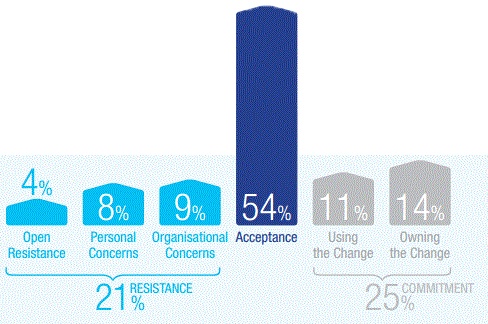As digital technologies continue to reshape the landscape in industry after industry managing the people aspects of the transition continues to be a central challenge for business leaders.
At the most fundamental level digital transformation in any company means a change to job roles. While not necessarily everyone is affected, a percentage of your employees will be facing a change in their day-to-day working pattern due to digitisation. It is this expectation of change that very often causes underlying resistance to change. Particularly at times of high disruption like now.

Digital change creates uncertainty and fear of change for individuals
The benefits of digitisation for a company are clear: greater efficiency, faster processing times, less errors, lower process costs, greater customer service; the list goes on.
However, sometimes the benefits of digital transformation for individual employees and teams are often not so clear - and uncertainty surrounding the future often results in fear in those being impacted. Fear of changes to their job, fear of a job role change, job losses, being faced with learning new skills, new technology or new ways of working.
Left un-managed, this uncertainty, this fear, results in significant organisational resistance to change, as people - when faced with uncertainty - naturally hold onto what they know.
Levels of commitment to change are not uniform
For those implementing the changes, often buoyed up with the excitement of delivering exciting new technology that will bring large benefits to the company, it is often easy to overlook the impact - both positive and negative - that these new systems will bring to your employees. And also to over-estimate the level of commitment needed to change within the organisation itself.

Source: Changefirst research data
As the excerpt from our own data above shows, there are various degrees of commitment or resistance that range from open resistance to change, to full commitment and taking ownership of the change itself.
7 steps to overcome resistance to digital transformation
So how do you put in place a plan to manage the personal impact of digital transformation and minimise the level of resistance to it?
While 100% commitment is unrealistic, there are some straightforward steps that you can ensure your project teams and leaders follow to overcome and reduce the level of resistance to your digital transformation
- Initial risk assessment and proactive risk management: An initial change management assessment provides an understanding of the potential challenges and complexities of implementing your planned changes. Early identification and implementation of actions to actively manage risks can even increase commitment to your digital transformation program.
- Tracking and measurement of risks & commitment: Regular tracking of people risks and commitment levels using a digital Change Management platform throughout the full lifecycle of your program gives clear insight into how these risks and commitment levels are changing; measuring the effectiveness of mitigation actions and the change in risk profile to your business transformation over time.

- Early engagement and 360˚ communication: As much as possible, start communication and engagement of teams early linking today’s actions with a clear future vision. Not only does this give people time to process and accept the upcoming business changes it also gives your project teams time to listen, understand and address the concerns of employees during the project. Don’t leave this step until implementation, as by this time it is too late.
- Upfront honesty: Most leaders don’t want to talk about negative topics: potential job losses or admitting that a system or process (which they may have been instrumental in creating in the first place) is no longer the right solution for the company. Being upfront and honest about known or possible impacts helps proactively manage the internal manage the rumour mill and allows your teams to stay focused on the reason for the change.
- Be clear on expectations: Often resistance is brought about by not knowing what is expected of an individual, or a team, during change. Manage this uncertainty by providing clarity on what actions and behaviours should stop, should change (and to what) and should continue. Each system and process impacted by the digital transformation needs to be covered.
- Look for opportunities to reward: Identify and reward those behaviours and actions that contribute to the transformation, through formal or informal rewards and recognition schemes. Ensure alignment to any overarching corporate values, behaviours and reward schemes to avoid confusion and miscommunication.
- Follow through: Increased resistance can occur once a specific implementation is over, as employees become disillusioned with the new system and fall back into old ways of working. A Change Management focus needs to be maintained until the changes introduced from your digital transformation become business as usual.
And alongside all of this you need a tool to manage the whole process productively - one that is unapologetically digital too.
You can gain more insight into key risks, critical success factors and suggested actions to overcome resistance to change in our ebook on People-Centred Data. Based on data from over 55,000 respondents, 900,000 data points and multiple industries, we provide you with insights and lessons learnt in overcoming resistance and delivering change that really sticks.
|
MANAGE, TRACK AND OVERCOME RESISTANCE TO CHANGE If you’re looking to overcome resistance in your digital transformation projects, you’ll need a way to manage the process efficiently and effectively – this is why we built Roadmap Pro. It’s an innovative digital transformation toolkit for delivering disruptive change, giving you the step-by-step process, tools, analytics data and learning you need for change project success. |





Leave a comment